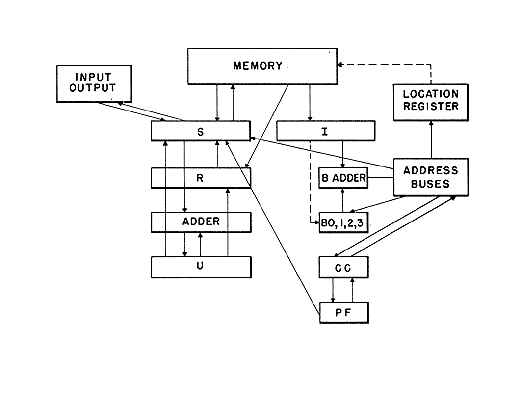Disclaimer: This MANIAC II manual was OCRed, spellchecked and HTMLed
(including links from Table of Contents to items) carefully,
but must be considered to contain errors. The conversion should be accurate,
baring undiscovered "I" for "1" and other substitutions that hopefully will not distract
from the usefulness. Some questionable spelling in the original is tagged with
[sp] . Charts were converted to .gif and .jpg
images to eliminate this point of error introduction. Some inline itemization
was made vertical for easier reading. Foot notes were moved to the referencing text
and inclosed with brackets [].
Best Regards

click here to see Cover
size is 20 Kbytes
LEGAL NOTICE
Printed in USA. Price 35 cents. Available from the
LA-2083
PHYSICS (Distributed according to
TID-4500, 12th edition)
LOS ALAMOS SCIENTIFIC LABORATORY
OF THE UNIVERSITY OF CALIFORNIA LOS ALAMOS NEW MEXICO
REPORT WRITTEN: October 1, 1956
REPORT DISTRIBUTED: Jan 30 1957
MANIAC II
Work done by: Report written by:
------------- ------------------
R. B. Lazarus R. B. Lazarus
N. Metropolis
W. Orvedahl
J. H. Richardson
W. Spack, Jr.
and
R. L. Bivins
J. V. Caulfield
I. Krai
A. F. Maimberg
G. T. McKinley
R. E. Williamson
Contract W-7405-ENG. 36 with the U. S. Atomic Energy Commission
In accordance with the intention that Maniac II will undergo modification and improvement, this report has been spiral-bound to allow insertion of new and replacement pages.
FOREWORD
ACKNOWLEDGEMENT
CONTENTS
INTRODUCTION
I. GENERAL
2. STORAGE
3. INFORMATION
The range, for a single word, non-zero number, N, is
or, approximately,
4. CONTROL
The tag for a purple breakpoint is virtual, only one instruction at a time can
be tagged with a purple breakpoint, and the tagging Is done by setting the
half-word storage location of the instruction on a set of Purple Breakpoint Switches.
5. MANUAL OPERATION
The upper row of 14 displays the effective address, which is the sum of the
address and the index, i.e., the sum of the number directly above and the
number directly below. Below the B Register lights is a row of 15 lights
displaying the address-plus-one-half of the last transfer performed (due either
to a transfer instruction or to a breakpoint transfer).
6. MANUAL INTERVENTION
7. SPECIAL INDICATORS
8. STOPS
9. VOCABULARY
Any vocabulary list necessarily involves a compromise between brevity and
completeness. This is particularly true as regards secondary changes in register
contents, changes not of interest in straightforward programming. It is also
true in regard to stops which may occur during the performance of an instruction,
such as those due to exponent spill. Since an Appendix to this report describes
in detail the secondary register changes and since preceding sections of this report
describe the various stops, the following vocabulary list leans toward brevity.
When b and m are not relevant for a particular instruction, they are replaced by dashes.
Page 31
instructions, about 25 K Bytes
10. INPUT-OUTPUT
II. PROGRAMS
APPENDIX
REGISTER CONTENTS UPON LEGAL COMPLETION OF ORDERS
SUMMARY OF MORE IMPORTANT SYMBOLS USED
Page 48
register contents, about 25 K Bytes
.
Page
Foreword
3
Acknowledgment
4
Introduction
7
1. General
9
2. Storage
11
3. Information
13
4. Control
15
5. Manual Operation
19
6. Manual Intervention
23
7. Special Indicators
25
8. Stops
27
9. Vocabulary
29
10. Input-Output
39
11. Programs
43
Appendix
45
The report has been written primarily for those who are already familiar
with electronic computers. It is to be expected that many questions will arise,
and it would be appreciated if such questions, along with any suggestions and
criticisms, were addressed to LASL Group T-7.

The average multiply time is about 160 usec.



MANIAC II Control Panel
size = 24 Kbytes
[Note that this is the B Register selected by the B bits; in the case of
Count B, etc., it is not the B Register being modified.]
[Exception: The contents of PF are destroyed by Fast Print and some
magnetic tape instructions.]
[If two or more switches are depressed simultaneously, no useful information will,
in general, be obtained, although, of course, no harm will be done.]
These switches are inoperative on Automatic.
In either event, depressing the Fetch Switch will cause the fetching of an instruction
from the location contained in CC, and depressing the Perform Switch will cause the
instruction currently in I to be performed.
Normal sequencing can be maintained only by the alternate action of the two switches.

Fig. 3
Page 32
instructions, about 25 K Bytes
Page 33
instructions, about 25 K Bytes
Page 34
instructions, about 25 K Bytes
Page 35
instructions, about 25 K Bytes
Page 36
instructions, about 25 K Bytes
Page 37
instructions, about 25 K Bytes

Fig. 4
Aids to the programmer can conveniently be divided into three classes:

Subdivisions of a binary number considered as floating-point
if óm = 1,
__
then óm = 0,
or if MR = 101110011. ...... 101,
__
then MR = 010001100.......010.
U Universal register
R R register
S S register
m Appropriate memory location \
|
E Exponent bits (-4 through 1) | after completion of
| the order
ó Sign bit (0) |
|
M Magnitude bits (1-43) /
-- Contents unchanged
a Answer i.e., primary result of operation
_
Z Reflection of Z, any Z.
Z' Contents of Z before the order was performed.
Page 49
register contents, about 25 K Bytes
Page 50
register contents, about 25 K Bytes
Page 51
register contents, about 25 K Bytes
Page 52
register contents, about 25 K Bytes
Page 53
register contents, about 25 K Bytes